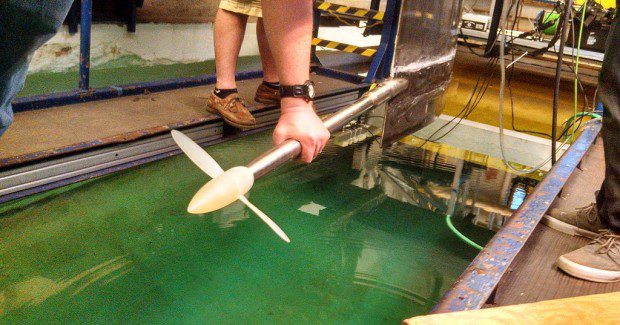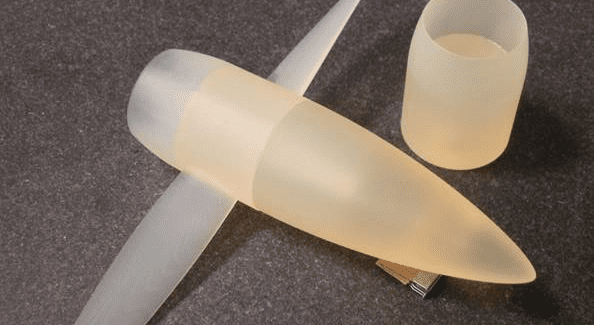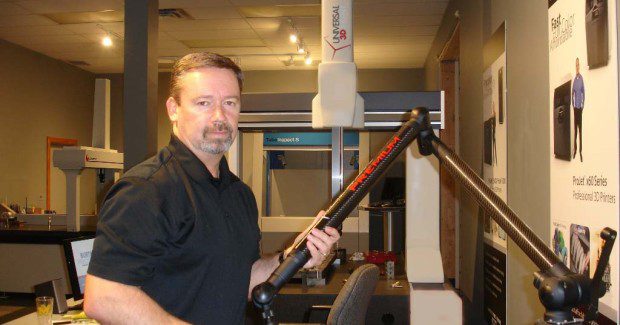Human Powered Submarine Team Produces 3D-Printed Propeller
Take a look at how metrology and 3D printing distributor Burton Precision applies 3D printing technology to solve a variety of CAD issues and challenges for producing a unique plastic propeller design for a human powered submarine.
Posted: June 19, 2014
Burton Precision (Grand Rapids, MI) is a machine tool distributor specializing in the application of metrology and 3D Printing products. Their involvement in manufacturing crisscrosses the breadth of industries with technologies that have a direct impact on successful product design and manufacture.
Most recently, a unique opportunity presented itself when the University of Michigan’s Human Submarine Team contacted Burton Precision to enlist some assistance in dealing with some CAD issues related to producing a propeller for a submarine that is designed and built by students.
Rick Kerkstra, the Burton Precision vice president and 3D printing specialist, recounts that this particular inquiry came via a very circuitous path. “We held an open house at Burton Precision for GR Makers in Grand Rapids which is an open community lab that incorporates elements of a machine shop, a workshop and a design studio. Members there work on projects that range from the industrial to the delicate arts. It’s a unique community that focuses on enabling personal expression, providing education and supporting entrepreneurship. We were demonstrating our metrology and 3D printing products for them. I met an individual there who mentioned that his brother belonged to the Human Powered Submarine Team at the University of Michigan and they were having problems with a point cloud file for a propeller design. More specifically, they couldn’t convert the file to a ‘friendly’ file that they could put to a cutter path on a CNC machine to make the part. I gave him my card. They called!”
http://youtu.be/jt5_OM0v5QI
An overview and demonstration of the ProJet 3500 HDMax printer from 3D Systems.
Specifically, Jeremy Werner called Mr. Werner, is with the University of Michigan’s Naval Architecture and Marine Engineering Department and he is the president of the Human Powered Submarine Team. He outlined the CAD issues they were having with a propeller design program called Open Prop™, which wasn’t allowing them to export files in a format that they could use to create a toolpath. He provided the students with the point cloud files which did not include outward normal vectors. The units were in m, and arranged with 100 rows of points along the length of the prop blade, and 40 points per row (20 on either side of the blade). Ultimately, they wanted to make the toolpath in GibbsCAM®.
Kerkstra explains, “I think Jeremy and I had about fourteen emails the first week so it wasn’t as simple as a file conversion. It usually never is. He sent me an STL file that I read into Geomagic® Studio Software in an attempt to create a nurbs surface. (A nurbs surface is a mathematical model commonly used in computer graphics for generating and representing curves and surfaces). Geomagic is a 3D Systems software package that is used on 3D Systems Printing machines.”
Kerksta adds, “We were dealing with low resolution files and an edge on the blade that was giving the surface creation fits! Jeremy did four or five re-writes before we had a file that we could use. Once we had a good surface file to give back to him, I asked if we could 3D print it for him… and that opened another door. We had further discussions about strength of material, testing using a scale version and overall functionality of the 3D printed part. The first surface files that we provided failed the initial testing in their simulator because the blade thickness was to thin. That was enlarged and the thicker blade passed. We 3D printed the propeller on a 3D Systems ProJet 3500 HDMax printer in a plastic material called Crystal. The blade assembly was 10-in long.”
Kerkstra explains further, “For projects like what we provided for this propeller design, one to two days is necessary to complete the data conversion, if we have clean printable files. Because 3D Printing technology is new to most of our customers, we still have to do some educating as to what it takes to develop a 3D printable file… that ultimately takes only a few hours to print the part.”
Jeremy Werner communicated, “Burton Precision became a key player in providing a hands-on learning experience for me and all the team members involved in the scale model propeller test. This kind of out-of-the-classroom training is at the core of our team’s mission statement, and everyone from outside U of M who contributes to that deserves special recognition.”
“We were invited to attend the full-scale, self-propelled test of the submarine and its systems on April 22, Kerkstra concluded. “The test was successful…the propeller worked perfectly…and we’re hoping to sell a 3D Printing machine to the University.”
Burton Precision is a Grand Rapids, Michigan–based machine tool distributor specializing in metrology and 3D Printing Products. This includes: 3D Systems printer sales, service and supplies; Geomagic® software; 3D prototype services; Renishaw® probing systems; KREON® laser scanners and portable measuring arms; reverse engineering services; coordinate measuring machines; contract measuring services, part sorting, video inspection systems.
The Human Powered Submarine team competes every year in one of two races; The International Submarine Races at the Naval Surface Warfare Center in Carderock, Maryland; The European International Submarine Races in Gosport, England. One of the team’s missions is to increase public awareness of underwater technology. In each race, the subs are timed through a 10-meter section of the races courses which are located in the David Taylor Model Basin and the QinetiQ Ocean Basin, two massive indoor water basins used by the US Navy and Royal Navy to test new ship designs.
Teams run the course one at a time, and may take as many turns as time allows over the course of the five-day competition. All of the submarines competing in the ISR are free flooding designs – meaning that there is no air inside the vehicle, so the pilot must use SCUBA gear to breathe during the race. The team is sponsored by the University of Michigan College of Engineering, Department of Naval Architecture and Marine Engineering, and companies like Burton Precision, Kaiser Aluminum, Chevron and Ford…to name a few.
Burton Precision Company, 5737 Vinton Ave. NW, Comstock Park, MI 49321, 616-784-1756, [email protected], www.burtonprecision.com.

















